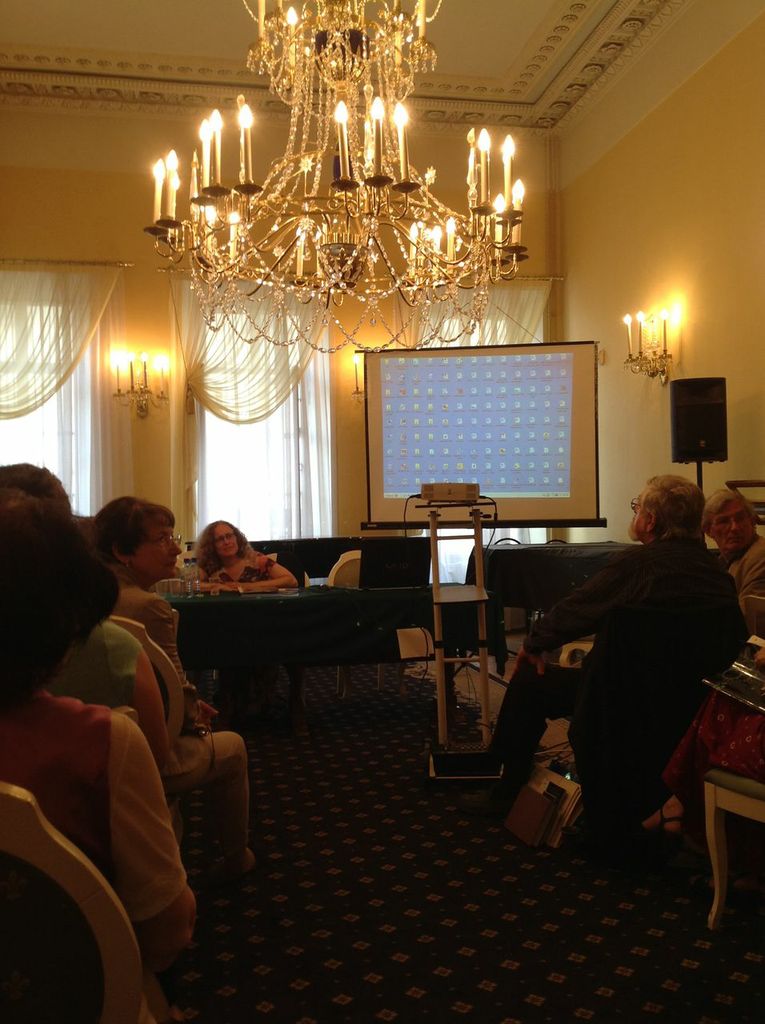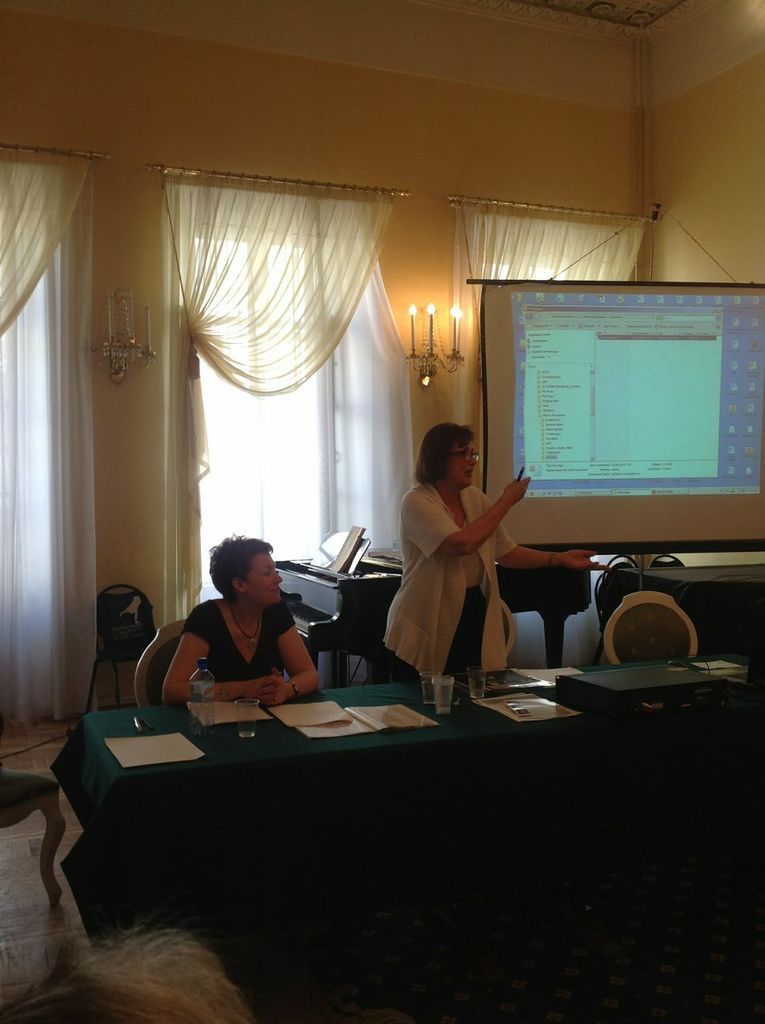"What do you think of the theory of K and Kh?" asked Professor Severine Neff at a recent conference in Moscow. No, this was not a discussion of the periodic table or component proteins. It was simply an intriguing tangent for a musical event: "Anniversary of a Masterpiece: Centenary of The Rite," also known as "Reassessing The Rite Part II," an academic symposium at the Moscow Tchaikovsky Conservatory centered around the centennial of Stravinsky's ballet The Rite of Spring and a follow-up to last fall's acclaimed conference in Chapel Hill, NC.
K and Kh, if you must know, were terms employed by the music theorist Allen Forte to discuss the relations between musical sets. Part of a broader discussion of theoretical approaches to unusual harmonies of The Rite, Professor Neff's question was among the many fascinating paths that "Reassessing The Rite Part II" offered. The scholars from the Chapel Hill conference presented their research for a second time, joined by new Russian perspectives on The Rite, which offered insights into an alternate history of that famous ballet.

Scholars Tamara Levitz and Richard Taruskin debate the so-called riot of The Rite (photo credit: Clara Yang)
The Rite of Spring had a very different trajectory in Russia than it did in Western Europe. Though conceived in St. Petersburg by a trio of Russians - choreographed by Vaslav Nijinsky, with a libretto and set design by Nicholas Roerich, and music by Stravinsky - the famous original ballet was never performed in Russia itself. Serge Koussevitsky gave performances of the concert work in 1914 in St. Petersburg, and afterwards the ballet had a spotty Russian history. Stravinsky never found the favor in Soviet Russia that Prokofiev or Shostakovich did. When Leonard Bernstein led the New York Philharmonic in The Rite on a tour to Moscow in 1959, it was the first time the work had been performed in the city in thirty years.
Today, though, The Rite is lauded in Russia, and "Reassessing The Rite Part II" was part of a broader embrace of Stravinsky's ballet, including a new choreography for the Mariinsky Theater by Sasha Waltz and a recent Moscow Rite festival with Tatiana Baganova's new version for the Bolshoi Ballet (the festival originally featured choreography by Wayne McGregor, which was postponed due to various intrigues at the company, including the infamous January acid attack of its director Sergei Fillin).
At the conference, scholars unpacked The Rite's various contexts. Tamara Levitz offered an analysis of the violence pregnant not only in The Rite's scenario but also in its reception. The 2013 celebrations of The Rite have embraced the somewhat historically-tenuous idea that it provoked a riot at its premiere, a fact that has obscured the forgotten, real riots of the 20th century. In fact, as Levitz pointed out, the victory of the conflation of The Rite with a riot can be attributed to impresario Serge Diaghilev, whose marketing ploy in engineering the scandal at the premiere has helped guarantee the work its legendary status today.
Stephen Walsh, author of the magisterial two-volume Stravinsky biography, offered an intriguing perspective on the dense polyrhythms of The Rite. One of the more famous aspects of the ballet is its alteration of rhythmic patterns, in which individual measures switch divisions of two and three at seemingly random intervals. Conductors have to memorize these patterns or the work simply falls flat.
Walsh, though, pointed out that these divisions are somewhat arbitrary, a convenience of Stravinsky's attempt to notate the effect he desired. We assume that Stravinsky was after polyrhythmic alternations, but in fact he was after what Walsh called "monometrics": an incessant emphasis on single beats, a tradition that dates back to 19th century composers like Modest Mussorgsky, whose Boris Godunov used monometrics to emphasize the rhythmic flow of Russian speech declamation. In focusing on the presence of monometrics in Stravinsky's Sacrificial Dance, Walsh showed not only the composer's radical rhythmic vision but also his ties to past Russian traditions.
Tying Stravinsky to past Russian tradition is the scholarly domain of Richard Taruskin, whose keynote lecture on "Resisting The Rite" continued to fascinate (you can read an abridged version in the New York Times). Taruskin pointed out the ways in which scholars, critics, composers, and yes, Stravinsky himself, avoided the original message of The Rite of Spring, sanitizing the work from its Russian origins as a neo-primitivist ballet and recontextualizing it as an abstract, virtuosic concert piece.
And Professor Neff offered up an analysis of one of those participants in the quasi-sanitization of The Rite: René Leibowitz, the composer and conductor whose 1962 recording of The Rite undertakes the unusual activity of analyzing Stravinsky's score through the analytical methods of his nemesis Arnold Schoenberg. In doing so, Leibowitz re-envisioned and critiqued The Rite as an Austro-German work; oddly, the unorrthodox tempos he employed were picked up by none other than Pierre Boulez, whose renditions of the Rite are the among most famous on record.
These, of course, were only a handful of the papers presented at the conference, which included astute commentary from dance scholars Millicent Hodson, Stephanie Jordan, Lynn Garafola, and Gabriele Brandstetter; music theory lectures by Pieter van den Toorn, Maureen Carr, and Ildar Khannanov; documentation of the relationship between Prokofiev and Stravinsky courtesy of Kevin Bartig; and a slew of Russian papers addressing a variety of perspectives on The Rite.
Several days later, three scholars also represented the University of North Carolina with lectures at the Conservatory College. Pianist Clara Yang gave an overview of American approaches to the piano, with a lecture-recital of works by Barber, Gershwin, Liebermann, and others. Composer Lee Weisert discussed the formal innovations underlying his own music. And I myself presented several of the Rite-inspired pieces that Carolina Performing Arts commissioned in its year-long "The Rite of Spring at 100" festival, including works by Colin Jacobsen, Vijay Iyer and Prashant Bhargava, and Dmitri Yanov-Yanovsky.
Of course, this conference was just one part of the celebration still unfolding. May 29, the anniversary of the ballet's Paris premiere, is nigh, and The Rite will be feted across the world. But between Moscow and North Carolina, The Rite has been fully reassessed.
Read more about Carolina Performing Arts's "The Rite of Spring at 100" festival here; this year's performances have concluded, but its new season will be announced on May 29. For more Huffington Post coverage of "The Rite at 100," click here. My thoughts on Stravinsky's shifting perspectives on The Rite can be read here.
